What are the pipes in the bathroom and how to hide them
Very often, repair in the bathroom is started only in order to remove from the view the communications passing through it. Usually we hide pipes in the bathroom in the wall, however there are other ways how to do this with its advantages and disadvantages. In this article we will talk about them, as well as share practical practical advice from experts who will help you in everything.

What pipes are used in the bathroom?
Before starting repairs, you should determine which pipelines you have to hide. You must clearly understand where and which of them runs, its turns and length for preventive maintenance or to eliminate blockages.
Tip: if you have an unpleasant smell from the pipes in the bathroom, check the siphons under the sink and the bathroom.
Typically, these types of pipes go through the bathroom:
- plumbing;
- sewer;
- heating.
The first to work in the easiest way, because:
- their wiring is located at a convenient level;
- there is always access to them;
- connections are located in accessible places.
When laying the sewage system one should not forget about the slope of the sewage pipes. And this applies to all drainage systems from the bath, sink and toilet. It also happens that additional heating radiators are installed in the bathroom from an autonomous heating system, the supply of which hot water system also needs to be hidden.
At the same time access to check the plumbing to prevent its performance should be free.
Tip: very often the question of why the pipes in the bathroom are noisy can be one answer - there are irregularities in the plumbing system of the neighbors or the general riser. After their correction, the hum usually stops.
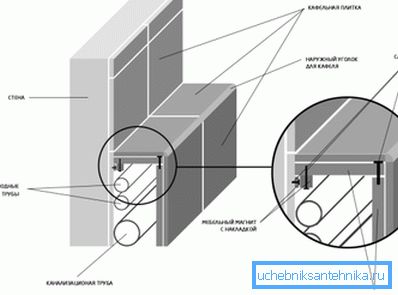
Kinds
Today in our apartments you can find the following main types of pipes:
| Metallic |
|
| Plastic | Usually there are the following:
|
| Polypropylene | It is these pipes that the experts recommend to “sew up” with various materials, since they do not have threaded connections. |
| Metal plastic | Easy to use, easy to do-it-yourself, reliable and durable. They are used for laying plumbing, connecting to a sewer or heating. |
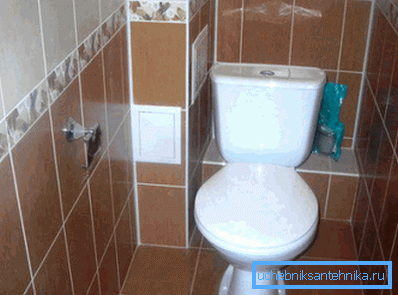
Advice: if you decide to hide metal plastic pipes behind the false wall, their fittings should be freely accessible.
Parsing points
Before you disguise the pipes in the bathroom, you need to determine the amount of work, for which you need to take into account all places of water extraction and branching of the pipeline.
Usually they are:
- bath - hot water supply, cold water supply and two drains (upper and lower);
- sink - DHW, cold water and 1-2 drain;
- toilet bowl - supply to the cistern and drain;
- washing machine - cold-water and drainage;
- heating tank - supply and drainage of water.
Tip: mark these places on the wall, so it will be easier to navigate while working on their closure false wall. You can also display this scheme on paper, accurately transferring the dimensions.
This will provide an opportunity to know in advance where any cabinets and other structures can be placed after work.
How to hide
There are several commonly used methods that have positive and negative sides. Their choice depends on the number of pipes in one place or access to them.
Consider them in more detail:
- Pipes in the bathroom can be hidden in the screed, if they are placed horizontally, or under plaster, when they are installed vertically. You can use for this:
- strobing;
- plaster;
- decorated tiles.
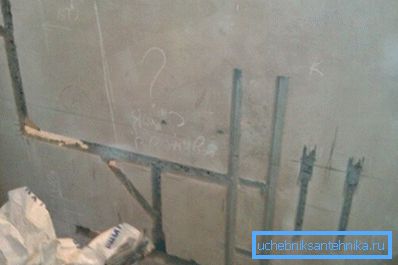
- Apply designs of plywood or moisture-resistant drywall. In this case, construct a box for pipes, close a solid sealed sheet or spend decorating tiles.
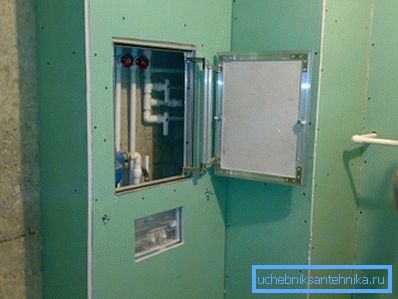
- Put the following constructions - furniture cabinets, rolling shutters or simple shelves, inside which pipes are placed and there is still room for household needs.
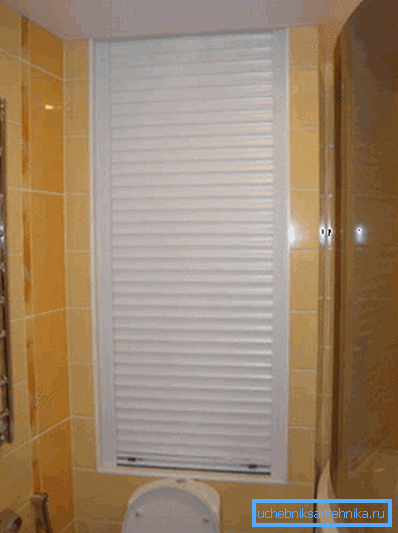
- You can creatively approach the solution of the problem by painting the pipes with paint, decorating them with a colored mosaic or stucco, using artificial lianas through the pipes.
Advice: do not close the pipeline elements where there are sections with thread, counters, control valves and adapters. They should always be easily accessible, otherwise, when the pipe is leaking in the bathroom, you will have to disassemble a part of the structure.
| In the screed | The method is interesting because after its completion you can simply forget about the pipes. The instruction is as follows:
Do not rush to use the bathroom, wait until the screed is completely dry, so that it does not burst. |
| Into the wall | There are three main options, consider each:
At first, you will need to make a frame with the help of profiles, to which you will then attach a VGKL. Also do not forget to make installation windows for counters, taps, filters.
|
| Shutters | An interesting way that is rarely used. In this case, you will have full access to plumbing and sewage systems. The shutters resemble roller shutters or blinds that fit snugly on the sides of the niche. They are installed to the level of panels or from the ceiling to the floor. Necessary parts for installation are included. When they open, they are wound on a shaft and unwind when lowering. At the bottom there is a kind of latch. |
| Furniture | Some argue that this method is the most practical of all. Suitable furniture can give the interior what the bathroom owners expect from it. Most often, for hiding pipes, lockers are meant that have shelves inside. The doors they hinged or sliding, depending on the proximity to the plumbing. The material is usually laminated waterproof chipboard, after the installation of which it is best to seal all the gaps in the corners and at the joints with transparent silicone, closing the access to the water. |

Conclusion
In this article, you learned how to clean the pipes in the bathroom under a false wall or in a regular one to improve the interior of the room. There are several ways to do this, the choice of each of which depends on certain conditions. The video in this article will help you find additional information on this topic.